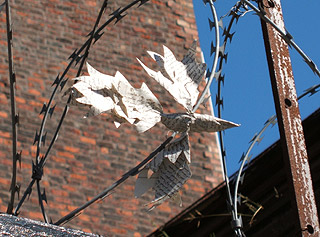
| HOME |
| NERVE |
| REVIEWS |
| ARCHIVE |
| EVENTS |
| LINKS |
| ABOUT US |
| CONTRIBUTORS |
| BACK ISSUES |
| CONTACT US |
Back to index of Nerve 12 - Summer 2008
Brutality and fear: the human costs of dawn raids
By Jon Burnett
 There
are some statistics that the New Labour government makes sure the public
know about. The constant rise in the number of police officers patrolling
British streets for example; the number of arrests that these police officers
carry out; or the relentless year by year increase in people incarcerated
in prisons up and down the country. Another of these statistics is the
number of people that are removed from the UK. The higher the figure,
the better; and last year this statistic reached an all time high. Every
eight minutes a person was removed, one way or another, from the country.
There
are some statistics that the New Labour government makes sure the public
know about. The constant rise in the number of police officers patrolling
British streets for example; the number of arrests that these police officers
carry out; or the relentless year by year increase in people incarcerated
in prisons up and down the country. Another of these statistics is the
number of people that are removed from the UK. The higher the figure,
the better; and last year this statistic reached an all time high. Every
eight minutes a person was removed, one way or another, from the country.
According to the Home Office, these numbers equate, quite simply, to a form of success: evidence that ‘strong controls are working’. So it is ironic that the means through which these figures are realised are shrouded in secrecy and misinformation. Dawn raids – or to use their official term ‘enforcement visits’ – are rarely discussed in the same self-congratulatory tones as the aims they supposedly achieve. And there is a reason for this. They are brutal. They rip people from their homes at the time that is least expected. And they tear families apart from each other; sometimes never to see each other again.
Dawn raids have emerged as a central facet of New Labour’s asylum and immigration policies, with little semblance of public debate. Statistics are not available to the public, yet what evidence there is suggests that dawn raids are carried out at rapid pace. Records of the number of dawn raids have only been made available since April 2005, but in the House of Commons in 2007, the Minister of State for Borders and Immigration explained that 8,100 ‘enforcement operations’ were carried out before 8 am in 2006. On average, that is roughly twenty-two dawn raids a day. Dawn raids are carried out explicitly for the purposes of detention and removal. Yet of these 8,100 conducted, only 2,009 led to arrests. A ‘success’ rate that equates to roughly one out of every four suggests that they are - from one perspective - an ineffective way of meeting government targets for ‘removing more failed asylum seekers than new anticipated unfounded applications’. Yet it is exactly these targets that continue to justify their use. Ensuring the former figure is higher than the latter is described as ‘public performance’ and according to Liz Fekete from the Institute of Race Relations, ensures that ‘[i]n the process, the fact that those who seek refuge…are human beings, not mere statistics, is lost’.
This reduction of people to statistics covers a horrifying level of abuse, harm, and fear. As stated above, dawn raids are particularly barbaric. They are carried out in the early morning – when people are most likely to be at home, asleep, and disorientated – apparently in ‘the interests of health and safety and to help minimise disruption’. But the reality of dawn raids suggests that health and safety is far down the list of priorities. For example, the 1993 raid on immigraion overstayer Joy Gardner led to her death, after she was placed in a body belt, had her wrists, thighs and ankles tied to handcuffs and belts, and thirteen feet of tape wrapped around her mouth to stop her making any noise.
Statistics for the number and nature of complaints made by people in relation to dawn raids are not available. But work by the Border and Immigration Agency Complaints Audit Committee gives some idea of mechanisms of redress. In their 2006/7 Annual Report the Complaints Audits Committee emphasised that 20% of records of complaints against BIA had gone ‘missing’ (although this was later reduced to 15%), and of complaints against arrest teams their audit sample showed that ‘none was handled in time’. Of overall complaints, those of criminal behaviour (some of which were assault) rose 7% from the previous year.
Where there is hope though, it rests within continuing actions of campaigners, many of whom are in the asylum process, who continue to display solidarity, raise awareness, and resist. In doing so, they emphasise not only their refusal to succumb to one of the fiercest tools available to the Home Office; but the wider polices in which these activities are concretely embedded.
This article is an edited version of the fourth in a series of briefing papers by Positive Action for Refugees and Asylum Seekers (PAFRAS), an independent charity based in Leeds. For further information about this, and other PAFRAS briefing papers visit www.pafras.org.uk/index.php?section=3&page=1